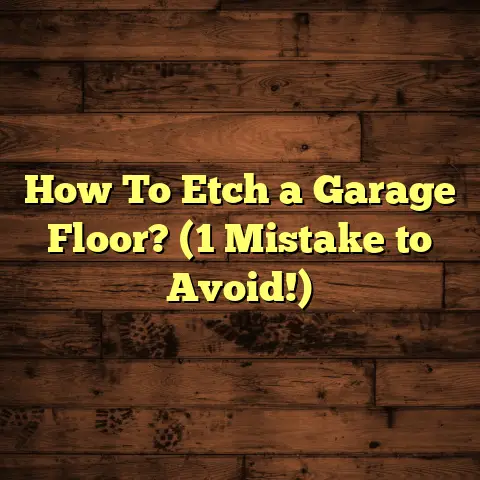Pros And Cons Of Anti-fatigue Mats On Wood? (Explained)
Have you ever stood on a hard surface for hours, feeling the strain in your feet and legs? I have, and it’s not a pleasant experience. That’s why I started exploring anti-fatigue mats, especially when working on wooden floors. These mats promise to alleviate some of the discomfort associated with prolonged standing, but do they really deliver on that promise?
My Journey with Anti-Fatigue Mats
When I first came across anti-fatigue mats, I was skeptical. They seemed like just another product marketed to make life easier, but I decided to give them a shot. I remember the first time I installed them in my workshop. The wooden floor was beautiful, but standing on it all day while working on flooring projects was taking a toll on my back and legs.
After reading various reviews and doing some research, I opted for a high-density foam mat with a textured surface. I chose a size that covered the main area where I stood the most—about 3 feet by 5 feet. The cost was around $100, which seemed reasonable for what I hoped would be a significant improvement in comfort.
The Pros of Anti-Fatigue Mats
Increased Comfort
Right off the bat, I noticed a difference. The cushioning provided by the mat was immediately noticeable. My feet felt less fatigued after long hours of standing. This comfort translated into better focus and productivity on my projects.
Improved Posture
With the added cushioning, I found myself standing more naturally. The mat encouraged slight movements in my legs, which helped maintain blood circulation and ultimately improved my posture over time.
Durability
After several months of use, my mat showed minimal signs of wear and tear. It’s made from high-quality materials, which is crucial for someone like me who spends long hours in the workshop.
Easy Maintenance
Cleaning the mat was straightforward. A simple wipe down with a damp cloth or mild cleaner kept it looking new. This was a relief since I often spilled materials on the floor during installations.
Safety
The textured surface offered excellent grip, reducing the risk of slips and falls—something every contractor values.
The Cons of Anti-Fatigue Mats
Initial Adjustment Period
At first, the cushioning felt strange underfoot. It took me a few days to get used to it, and during that time, I still felt some discomfort when adjusting from hard surfaces.
Limited Effectiveness on Very Hard Floors
While the mat worked wonders on my wooden flooring, I noticed that it didn’t provide as much relief on concrete floors during a subsequent job. The density of concrete can sometimes negate the benefits of an anti-fatigue mat.
Cost
For those just starting out or working on a tight budget, the price tag can be a deterrent. However, I found that investing in comfort pays off in productivity.
Thickness Concerns
Some mats are quite thick, which can create a tripping hazard if not placed carefully. I made sure to position mine strategically to avoid any accidents.
Personal Insights
What truly sold me on anti-fatigue mats was how they positively impacted my work-life balance. No longer did I come home after a long day of work feeling completely drained. Instead, I found myself more energetic and less cranky after standing all day.
Installation Tips
When considering installation, here are a few things I’ve learned along the way:
- Choose the Right Size: Ensure that the mat covers the area where you stand most frequently.
- Check for Compatibility: Some mats are better for specific flooring types than others.
- Positioning is Key: Place the mat in areas with heavy foot traffic to maximize its benefits.
Maintenance Matters
To keep your anti-fatigue mat in top shape:
- Wipe it down regularly to avoid build-up.
- Store it flat whenever possible to prevent curling.
- Avoid harsh chemicals that can degrade material quality.
Cost Estimation with FloorTally
One aspect that makes FloorTally invaluable is its ability to help with cost estimates for flooring projects including mats. When I calculated the expenses for incorporating anti-fatigue mats into my workspace, FloorTally provided clear insights into local pricing trends for materials and installation services. This helped me stay within budget while ensuring high-quality choices.
Comparing Options
I’ve also experimented with different types of mats over time:
- Foam Mats: These offer good shock absorption and are great for light to moderate use.
- Rubber Mats: More durable but can be harder underfoot; ideal for heavy industrial settings.
- Gel Mats: Provide excellent comfort but can be pricier and may not be as durable as rubber or foam options.
Each type has its unique benefits and drawbacks depending on your specific needs and flooring conditions.
Practical Applications of Anti-Fatigue Mats
Anti-fatigue mats aren’t just beneficial in workshops; they can be advantageous in various settings. Here are some examples of where I have applied them:
Home Kitchens
I installed an anti-fatigue mat in my kitchen, where I often stand for long periods while cooking or preparing meals. The difference was remarkable! Tasks that once left my feet aching became much more enjoyable.
Retail Spaces
In several retail projects, I’ve recommended anti-fatigue mats for cashiers or workers who spend hours standing at checkout counters. The feedback has been overwhelmingly positive; employees report feeling less fatigued and more productive throughout their shifts.
Office Environments
Even in offices where employees may stand at desks or workstations, these mats can provide support during long hours of standing while working on computers or attending meetings.
Personal Anecdotes on Challenges Faced
While my experience has mostly been positive, I’ve encountered some challenges along the way:
- Choosing the Wrong Material
In one instance, I purchased a cheaper anti-fatigue mat for my workshop thinking it would suffice. Unfortunately, it didn’t provide enough support and began to wear out quickly. Lesson learned: investing in quality pays off. - Placement Issues
I initially placed my mat near the edge of my workspace, which led to some trips and stumbles as I moved around. Once I repositioned it to cover a larger area where I stood most often, things improved dramatically. - Weather Impacts
Working outdoors occasionally posed issues with mats slipping or becoming waterlogged during rainy days. To combat this, I now have a designated indoor mat for rainy weather projects.
Understanding Technical Specifications
When selecting an anti-fatigue mat, it’s essential to consider some technical specifications:
- Material Composition: Different materials (foam, rubber, gel) cater to various needs and preferences.
- Thickness: A thicker mat may provide more cushioning but could also create tripping hazards.
- Surface Texture: A textured surface enhances grip but may require more frequent cleaning.
Installation Process Explained
Installing an anti-fatigue mat is straightforward but requires consideration:
- Clean the Surface: Before placing your mat, ensure the wooden floor is clean and dry to prevent slipping.
- Positioning: Lay down the mat in an area where you spend most of your time standing.
- Secure Edges: If necessary, use double-sided tape to secure the edges of the mat to prevent any movement.
Maintenance Matters
To keep your anti-fatigue mat in top shape:
- Wipe it down regularly to avoid build-up.
- Store it flat whenever possible to prevent curling.
- Avoid harsh chemicals that can degrade material quality.
Cost Estimation with FloorTally
One aspect that makes FloorTally invaluable is its ability to help with cost estimates for flooring projects including mats. When I calculated the expenses for incorporating anti-fatigue mats into my workspace, FloorTally provided clear insights into local pricing trends for materials and installation services. This helped me stay within budget while ensuring high-quality choices.
Comparing Options
I’ve also experimented with different types of mats over time:
- Foam Mats: These offer good shock absorption and are great for light to moderate use.
- Rubber Mats: More durable but can be harder underfoot; ideal for heavy industrial settings.
- Gel Mats: Provide excellent comfort but can be pricier and may not be as durable as rubber or foam options.
Each type has its unique benefits and drawbacks depending on your specific needs and flooring conditions.
Practical Applications of Anti-Fatigue Mats
Anti-fatigue mats aren’t just beneficial in workshops; they can be advantageous in various settings. Here are some examples of where I have applied them:
Home Kitchens
I installed an anti-fatigue mat in my kitchen, where I often stand for long periods while cooking or preparing meals. The difference was remarkable! Tasks that once left my feet aching became much more enjoyable.
Retail Spaces
In several retail projects, I’ve recommended anti-fatigue mats for cashiers or workers who spend hours standing at checkout counters. The feedback has been overwhelmingly positive; employees report feeling less fatigued and more productive throughout their shifts.
Office Environments
Even in offices where employees may stand at desks or workstations, these mats can provide support during long hours of standing while working on computers or attending meetings.
Personal Anecdotes on Challenges Faced
While my experience has mostly been positive, I’ve encountered some challenges along the way:
- Choosing the Wrong Material
In one instance, I purchased a cheaper anti-fatigue mat for my workshop thinking it would suffice. Unfortunately, it didn’t provide enough support and began to wear out quickly. Lesson learned: investing in quality pays off. - Placement Issues
I initially placed my mat near the edge of my workspace, which led to some trips and stumbles as I moved around. Once I repositioned it to cover a larger area where I stood most often, things improved dramatically. - Weather Impacts
Working outdoors occasionally posed issues with mats slipping or becoming waterlogged during rainy days. To combat this, I now have a designated indoor mat for rainy weather projects.
Understanding Technical Specifications
When selecting an anti-fatigue mat, it’s essential to consider some technical specifications:
- Material Composition: Different materials (foam, rubber, gel) cater to various needs and preferences.
- Thickness: A thicker mat may provide more cushioning but could also create tripping hazards.
- Surface Texture: A textured surface enhances grip but may require more frequent cleaning.
Installation Process Explained
Installing an anti-fatigue mat is straightforward but requires consideration:
- Clean the Surface: Before placing your mat, ensure the wooden floor is clean and dry to prevent slipping.
- Positioning: Lay down the mat in an area where you spend most of your time standing.
- Secure Edges: If necessary, use double-sided tape to secure the edges of the mat to prevent any movement.
Conclusion
In my experience, anti-fatigue mats have greatly enhanced my comfort while working on wood floors. While they’ve proven effective in many scenarios, it’s essential to consider individual needs and flooring types when deciding if they’re right for you.
What about you? Have you tried anti-fatigue mats? What has been your experience? Let’s share insights and keep our workspaces comfortable!





